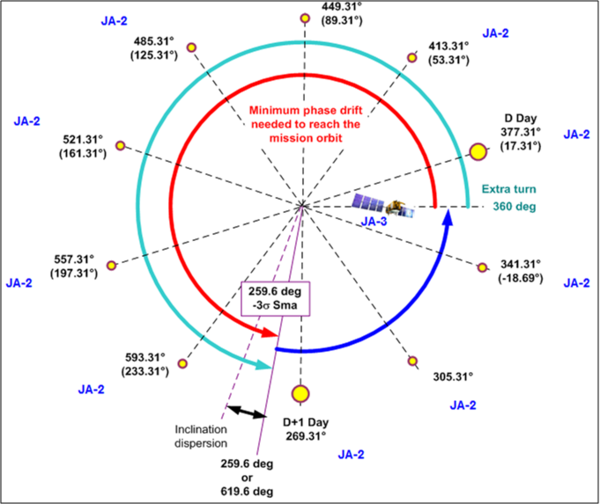Launch and early orbit phase
Jason-3 was launched from the American Air Force base in Vandenberg, California, USA on 2016/01/17. The launcher chosen by NASA is the Falcon 9 rocket from Space X, which is certified to launch this satellite. Once the satellite is separated, the early orbit phase and acceptance testing is carried out by Cnes in Toulouse.
See below the highlights of this successful launch.
Credits Cnes, 2016.

Jason-3 : D-1 before the launch !
2016/01/16: All activities are going smoothly, the Launch Readiness Review will be performed today in Vandenberg. We are now about less than 30 hours before the Jason-3 lift-off.[more]
Jason-3 Launch Readiness Review successful
2016/01/16: Launch Readiness Review has been successfully held on Jan 15th in Vandenberg. The operations continue toward a launch in just less than 24 hours. Falcon9 was nominally rolled to the launch pad.[more]
Jason-3 on top of the SpaceX Launcher.
2016/01/17: Falcon 9 is poised for launch from Vandenberg Air Force Base with the Jason-3 ocean altimetry satellite aboard.[more]
Jason-3 mission on Nasa TV.
2016/01/17: During a Jan. 15 briefing on NASA Television, panelists gave an overview of the Jason-3 mission – scheduled to launch on Jan. 17 from Vandenberg Air Force Base in California. Jason-3 is the newest in a series of satellites...[more]
Jason-3 launch timeline
2016/01/17: About 154 seconds after the Falcon-9 rocket lifts off, the main engine will cut off. About three seconds after that, the rocket's first stage will separate. Second-stage ignition will follow in about eight seconds. Half a minute...[more]
Two hours to go: everything is nominal
2016/01/17: Satellite, launcher and ground segment have all a nominal behavtor toward a launch of Jasno-3 in about 2 hours from now. [more]
Jason-3 launch : less than 1 hour remaining
2016/01/17: At Space Launch Complex 4 at Vandenberg Air Force Base in California, a SpaceX Falcon 9 rocket stands ready to boost the Jason-3 spacecraft into orbit.[more]
Ten minutes to go...
2016/01/17: All is going smoothly but with a deep fog. [more]
Jason-3 in orbit
2016/01/17: Flying from Vandenberg Air Force Base, the SpaceX Falcon9 rocket lifted off with the Jason-3 spacecraft at 18:42 UTC. The attempt to land the first stage on the ASDS in the Pacific Ocean was unsuccessful. [more]
Jason-3 Doris instrument switched on
2016/01/18: The DORIS instrument has been successfully switched ON today at 5:40 UTC. The instrument behavior is fully nominal and has started to compute the on-orbit solutions thanks to the DIODE software.[more]
Jason-3 mission successfully launched, Release Press from Cnes
2016/01/18: Jason-3 was successfully launched Sunday 17 January at 18:42 UTC from Vandenberg, California. The satellite is now under control of teams at CNES’s Toulouse Space Centre in charge of powering up the bus and payload. [more]
Jason-3 Doris instrument provides real-time ephemeris
The DIODE software onboard Jason-3 DORIS instrument provides real time ephemeris since yesterday around noon. The data quality was impacted by the satellite attitude law (so-called barbecue) but since today Jason-3 is using a... [<link en news front-page-news>more]
Jason-3 altimeter first calibrations
19.01.2016: The Poseidon-3 altimeter has provided its first calibrations data and everything is inline with specifications. [<link en news front-page-news>more]
Jason-3 Altimeter first waveforms
2016.01.19: The Jason-3 altimeter has provided its first waveforms and the analysis confirm the good behavior of the instrument. [<link en news front-page-news>more]
Jason-3 mission returns first data
2016.01.19: Jason-3 was successfully launched Sunday 17 January. All the instruments were rapidly switched on. The first real-time Jason-3 data product was generated and compared with Jason-2, less than three days after launch. [<link en news front-page-news>more]
Injection in orbit

Injection orbit is 25 km below the nominal Jason-3 orbit to avoid polluting the operational orbit and to avoid to cross the Jason-2 orbit (and Jason-1). The duration for station acquisition and number of maneuvers depends on the launch date (day number in the Jason cycle), and on the launcher dispersions. The target duration for this station acquisition should not exceed 1 month.




